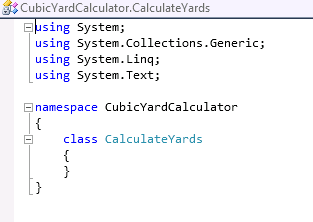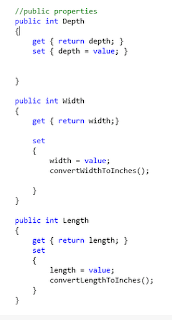This example creates a user defined class called CubicYardCalculator. First Add a new Class to the project and name it "CubicYardCalculator."

This gives you an empty class:

First we add the class level fields. These are class level variables that describe the object. In our case the cubic yards needs three variables to describe it, height, width and depth. I also have added a constant to store the value of a cubic yard in terms of inches (36 * 38 * 36). We will need this later when doing the calculations since we convert everything into inches to do the math and then back to cubic yards.

The fields are private to protect them. This is a part of the object oriented principle called Encapsulation. We will expose them to other classes through special methods called properties. Properties let you set the value and get the value returned. You can use properties to validate the input. You can also let people "get" the value of a field, but not "set" it, or visa versa. We will modify the Width and Length properties shortly.

Properties are different from other methods in that they don't take parameters. Therefore they don't have a () at the end of the declaration
Next we will enter the class methods. I make three of them. One to convert Width to inches, another to convert Length to inches and a third to get the cubic yards. The first two are private, meaning they can only be accessed internally in this class. The last method is public. That means we can call it from another class.

So, what are we going to do with those private methods? I am going to call them from the properties so that we can guarantee that they will be converted to inches. Here are the modified properties.

We are almost done with this class. The last things I am going to add are two constructors. Constructors "construct" a class. They set it up by initializing any variables and calling any methods that should be called.
If you don't create a constructor, the compiler creates a default constructor that initializes every thing to 0 or null. If you make your own constructors the compiler will no longer create a default constructor and it is up to you to initialize your variables.
Constructors can be overloaded. That means you can have multiple constructors as long as they can be clearly distinguished from each other. It is important to note that no matter how many constructors you have only one at a time is used for any particular instance of a class.
Constructors always have the same name as the class, and unlike other methods, they have no return type.

Why have multiple constructors? It gives the user of the class choices. Now they have two ways to initialize the class. They can choose the way that works best in their context.
Next we will instantiate and call our new class from the program class. First I will make a method to use the default constructor--the one that doesn't take arguments. When I use it, I have to use the properties directly to set the values. For brevity I am simply giving it literal values. You could, and should of course, get user input for these values. Here is the first method and the result when it is run.


No here is the code for using the overloaded constructor. Again I am just passing it literal values.


No comments:
Post a Comment